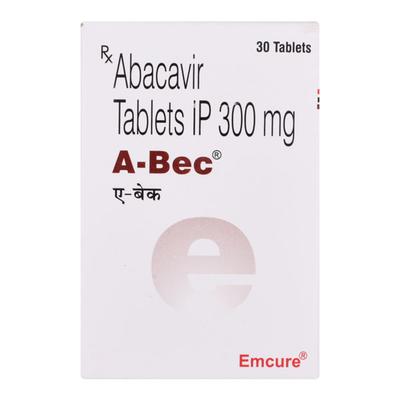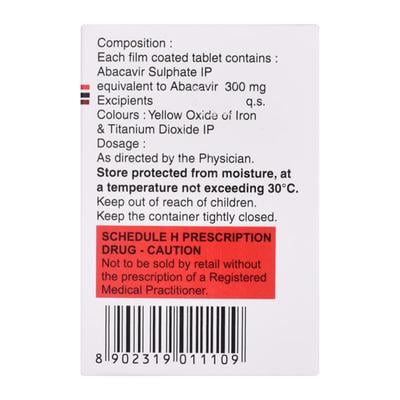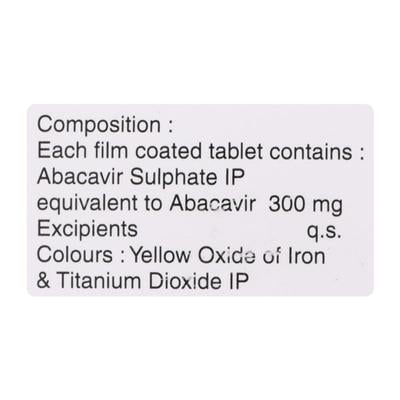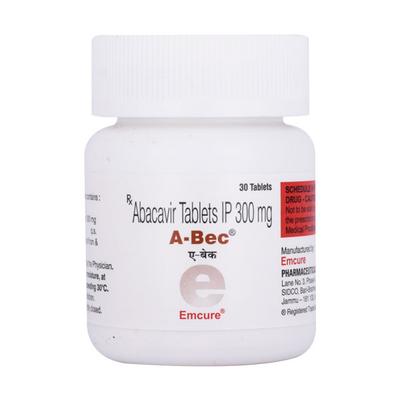

Netmeds First Membership
Quick Links
Introduction About A BEC 300MG TABLET
A BEC 300MG TABLET contains Abacavir which belongs to the group of medicines called Anti-viral agents. It is used to manage HIV infection. HIV (Human Immunodeficiency Virus) infection is a viral infection that damages our immune system and weakens our body’s ability to fight against various other opportunistic infections.
Do not take A BEC 300MG TABLET if you are allergic to abacavir. Before taking A BEC 300MG TABLET inform your doctor if you have any liver, kidney or heart problems. You must also inform your doctor if you have diabetes, high blood pressure or high blood cholesterol levels as a precaution.
While undergoing therapy with A BEC 300MG TABLET, it is important for you to follow certain measures to manage the spread of infections to the other people (such as avoid having unprotected sexual intercourse or sharing needles or personal items like toothbrush, razors etc with other people). A BEC 300MG TABLET is not recommended for use in pregnant or breastfeeding women.
A BEC 300MG TABLET cannot not manage HIV infection completely. It can reduce only the number of viral cells present in the body and maintains them at a lower level. During management with A BEC 300MG TABLET your doctor will closely monitor your body weight, blood cholesterol levels and blood sugar levels to reduce the risk of unwanted side effects.
The most common side effects of taking A BEC 300MG TABLET are fever, skin rash, nausea, stomach pain, headache and tiredness. Consult your doctor if any of these side effects worsens.
Uses Of A BEC 300MG TABLET
- Manage HIV infection
How A BEC 300MG TABLET Works
A BEC 300MG TABLET is an anti-viral medicine. It controls the multiplication of viral cell within the body, by blocking the actions of certain viral enzymes (HIV-reverse transcriptase) that is required for the viral cell to grow and multiply. It can also improve immunity in the affected patients by increasing the numbers of certain types of white blood cells (CD4) in the body which is required to fight against various infections.
How to use A BEC 300MG TABLET
Take A BEC 300MG TABLET as directed by your physician. Swallow the medicine with a glass of water. Do not crush or chew the medicine. A BEC 300MG TABLET can be taken with or without meals.
Your doctor will decide the correct dose and duration of therapy for you depending upon your age, body weight and severity of the infection. Do not stop taking A BEC 300MG TABLET without consulting your doctor as it may reduce its effectiveness.
Side Effects Of A BEC 300MG TABLET
Common
- headache, tiredness
- nausea, vomiting, diarrhoea
- fever, skin rash
- stomach pain
- loss of appetite
- joint pain, muscle pain
Rare
Stop taking A BEC 300MG TABLET and contact your doctor immediately if you experience any of the following side effects:
- signs of allergic reactions (such as skin rash, fever, accompanied with sore throat, cough, nausea, vomiting, stomach pain, diarrhea, tiredness, joint pain, muscle pain, swelling of the neck, difficulty in breathing, mouth ulcers, occasional headaches, inflammation of the eye, low blood pressure, sense of tingling or numbness of hands or feet)
How To Manage Side Effects
Diarrhea
Drink plenty of fluids, such as water or fruit juice to keep yourself hydrated. Consuming ORS can also be beneficial. Do not consume any medicine on your own without consulting your doctor. If your diarrhea worsens, contact your doctor immediately.
Headache
Rest and relax. Keep yourself hydrated by drinking plenty of fluids such as water or electrolytes. Applying a pain-relieving balm on your forehead can be beneficial. Do not consume excessive alcohol, as it could aggravate your headache. Consult your doctor if your headache worsens.
Nausea And Vomiting
Take A BEC 300MG TABLET with or just after a meal or a snack. Stick to simple meals. Avoid eating rich or spicy food. Consult your doctor if your nausea worsens.
Warning & Precautions
Pregnancy
ContraindicatedA BEC 300MG TABLET is not recommended for use in pregnant women. Therefore, consult your doctor before taking it.
Breastfeeding
Consult your doctorBreastfeeding should be discontinued in mothers infected with HIV infection. Therefore, consult your doctor for advice.
Driving and Using Machines
Use with CautionDo not drive or operate any machines if your ability is affected by A BEC 300MG TABLET.
Alcohol
Use with CautionAvoid consumption of alcohol while taking A BEC 300MG TABLET.
Kidney
Use with CautionA BEC 300MG TABLET should be used with caution in patients with severe kidney problems. Therefore, consult your doctor before taking it.
Liver
Use with CautionA BEC 300MG TABLET should be used with caution in patients with moderate to severe liver diseases (including previous history of Hepatitis B or C infection). Therefore, consult your doctor before taking it.
Allergy
ContraindicatedDo not take A BEC 300MG TABLET if you are allergic to abacavir.
Heart Disease
Use with CautionA BEC 300MG TABLET should be used with caution in patients with heart problems. Therefore, consult your doctor before taking it.
Use In Pediatrics
Consult your doctorA BEC 300MG TABLET can be used in children who weigh at least 14 kg or more if prescribed by the physician. Therefore, consult your doctor before taking it.
Use In Geriatrics
Use with CautionA BEC 300MG TABLET should be used with caution in elderly people. Therefore, consult your doctor before taking it.
Others
A BEC 300MG TABLET is not recommended for use if you:
- have a genetic problem (called as HLA-B*5701 allele)
Before taking A BEC 300MG TABLET inform your doctor if you:
- are overweight
- have diabetes
- have high blood cholesterol levels
- have high blood pressure
- smoke
Interactions
A. Drug-Drug interactions:
Before taking A BEC 300MG TABLET inform your doctor if you are taking any of the following medicines such as:
- phenytoin (a medicine used to manage epilepsy)
- methadone (a medicine used for pain relief)
- riociguat (a medicine used to manage increased pressure in the lungs)
Overdosage:
If you or anyone else accidentally took more A BEC 300MG TABLET, consult your doctor immediately.
Synopsis
| Drug | : | Abacavir |
| Pharmacological Category | : | Nucleoside Reverse transcriptase inhibitors |
| Therapeutic Indication | : | HIV infection |
| Dosage Forms | : | Tablet |
More Information
Storage
- Keep A BEC 300MG TABLET out of reach of children
- Store A BEC 300MG TABLET at room temperature
FAQs About A BEC 300MG TABLET
Q: What is A BEC 300MG TABLET?
A: A BEC 300MG TABLET is an antiviral medicine used to manage HIV infection. It acts by reducing the multiplication of viral cells within the body. It also improves immunity by increasing the numbers of certain white blood cells (CD4) in the body which is required to fight against various infections.
Q: Is A BEC 300MG TABLET safe?
A: A BEC 300MG TABLET is safe at doses prescribed by the physician.
Q: How does A BEC 300MG TABLET work in our body?
A: A BEC 300MG TABLET acts by blocking the actions of certain viral enzymes (HIV-reverse transcriptase) that is required for the viral cell to grow and multiply. This reduces multiplication of viral cells. It can also offer immunity in the affected patients by increasing the number of certain types of white blood cells (CD4) in the body which is required to fight against various infection.
Q: What are the signs of hypersensitive reaction that is possible after taking A BEC 300MG TABLET?
A: A BEC 300MG TABLET may cause certain signs of infections or hypersensitive reactions such as skin rash, fever, accompanied with sore throat, cough, nausea, vomiting, stomach pain, diarrhea, tiredness, joint pain, muscle pain, swelling of the neck or difficulty in breathing. If you experience any of these side effects, stop taking A BEC 300MG TABLET and consult your doctor immediately.
Q: Can I stop taking A BEC 300MG TABLET if I feel unwell?
A: No. Do not stop taking A BEC 300MG TABLET without consulting your doctor. Take A BEC 300MG TABLET regularly, because if you miss a dose of A BEC 300MG TABLET or take it at irregular intervals, you may experience some unpleasant reactions. If you wish to discontinue A BEC 300MG TABLET due to unpleasant symptoms, consult your doctor for advice.
Q: What to do if I forget to take a dose of A BEC 300MG TABLET?
A: If you miss a dose of A BEC 300MG TABLET take it as soon as you remember. However, if it is time to take the next dose, skip the missed dose and take the next one at regular time. Do not take a double dose of A BEC 300MG TABLET to compensate the missed dose.
Q: Can A BEC 300MG TABLET manage HIV completely?
A: No. A BEC 300MG TABLET cannot not manage HIV infection completely. It can reduce only the number of viral cells present in the body and maintains them at a lower level.
Q: What are the precautions to be followed while taking A BEC 300MG TABLET?
A: Before taking A BEC 300MG TABLET inform your doctor if you have diabetes or any liver (hepatitis C or B infection), kidney or heart problems. Regularly visit your doctor and take all the blood tests recommended for you. Consult your doctor before taking A BEC 300MG TABLET if you are pregnant or breastfeeding. Do not stop taking A BEC 300MG TABLET without consulting your doctor. inform your doctor immediately if you experience any signs of allergic reactions after taking A BEC 300MG TABLET.
Q: Can A BEC 300MG TABLET be used in children?
A: A BEC 300MG TABLET can be used in children who weigh at least 14 kg or more if prescribed by the physician. Therefore, consult your doctor before taking it.
Q: How to take A BEC 300MG TABLET?
A: Take A BEC 300MG TABLET as directed by your physician. Swallow the medicine with a glass of water. Do not crush or chew the medicine. A BEC 300MG TABLET can be taken with or without meals. Continue to take A BEC 300MG TABLET regularly as advised by your physician for maximum benefits.
Q: Is A BEC 300MG TABLET safe in pregnancy?
A: A BEC 300MG TABLET is not recommended for use during pregnancy. It may affect the growth of the unborn baby. Therefore, consult your doctor before taking it.
Q: Can A BEC 300MG TABLET cause diarrhea?
A: Yes. Diarrhea is a common side effect of A BEC 300MG TABLET. Drink lots of fluids, such as water or fruit juice to keep yourself hydrated. Do not consume any medicine on your own without consulting your doctor. If you experience persistent diarrhea, consult your doctor.
References
1. KD. Tripathi. Antiviral Drugs. Essentials of Medical Pharmacology. 7th Edition. 2013. Page – 808.
2. Jared Vincent Fernandez; Ahmed Munir. Abacavir. StatPearls. NIH. National Library of Medicine. National Center for Biotechnology Information. PMC. PubMed Central. May 2022. [Accessed on 13th August 2024] https://www.ncbi.nlm.nih.gov/books/NBK537117/
3. P S Hervey, C M Perry. Abacavir: a review of its clinical potential in patients with HIV infection. NIH. National Library of Medicine. National Center for Biotechnology Information. Pubmed.gov. August 2000. [Accessed on 13th August 2024] https://pubmed.ncbi.nlm.nih.gov/10983741/
4. Dr. Reddy’s Laboratories (UK) Ltd. Electronic Medicines Compendium (EMC). [Revised in December 2021] [Accessed on 13th August 2024] https://www.medicines.org.uk/emc/files/pil.10525.pdf
5. Cipla Ltd. Abamune Tablets. Ciplamed.com. [Revised in November 2018] [Accessed on 13th August 2024] https://www.ciplamed.com/product-index/abamune-tablets
Useful Diagnostic Tests
- Complete Blood Count (CBC)/ Hemogram
- Liver Function Test (LFT)
- Cd4 Absolute Count
- Hiv Preventive Package
- HIV 1&2 Antibodies
- HIV Viral Load (Quantitative) Test
- Western Blot For Hiv
- HIV-Dna Pcr - Qualitative
- HIV-Rna Pcr - Qualitative
- HIV Monitoring - I











